Table of Contents
If you’ve ever found yourself confused about which eBook format to choose—EPUB or MOBI—you’re not alone! It’s a common dilemma for readers and writers alike, given the vast number of devices and apps available today. Each format has its quirks, and figuring out the right one can feel like solving a puzzle.
But don’t worry! Stick with me, and I’ll walk you through the key differences, the strengths of each format, and help you decide when to use which. By the end of this, you’ll feel empowered to choose the best format for your needs.
We’ll dive into what EPUB and MOBI are all about, explore their compatibility, and even discuss how to convert between them. With this handy guide, you’ll have all the info to choose your perfect eBook format!
Key Takeaways
- EPUB is versatile and compatible with various devices, while MOBI is designed primarily for Kindle.
- Choose EPUB for dynamic content, multimedia support, and flexibility in editing.
- MOBI is ideal for readers embedded in the Kindle ecosystem and for self-publishing on Kindle Direct Publishing.
- Converting between EPUB and MOBI is simple with tools like Calibre; always check for formatting issues after conversion.
- Your choice should reflect your reading preferences—go with EPUB for flexibility and accessibility or MOBI for a streamlined Kindle experience.

EPUB vs MOBI: Key Differences Explained
EPUB and MOBI are two popular ebook formats, each with its unique features and advantages.
EPUB is more versatile when it comes to compatibility as it’s supported on a wide variety of devices like tablets, smartphones, and various readers, including Apple Books and Adobe Digital Editions.
MOBI, on the other hand, is primarily associated with Amazon Kindle devices, which makes it less flexible but is tailored for that ecosystem.
Understanding the differences can help you choose the one that fits your reading or publishing needs better.
What is EPUB?
EPUB stands for Electronic Publication and is an open eBook standard widely adopted across various platforms.
This format allows for reflowable content, making it easy to read on different screen sizes.
With features like support for multimedia, interactivity, and embedded fonts, EPUB provides a dynamic reading experience.
You can easily read EPUB files on devices like the iPad or Nook, or through apps like [Adobe Digital Editions](https://automateed.com/how-to-publish-a-graphic-novel/).
If you want to create or edit an EPUB file, various tools are available, such as Calibre—a comprehensive software for ebook management.
What is MOBI?
MOBI stands for Mobipocket and is a format developed for eBooks, particularly designed for Kindle devices.
MOBI files can be easily read on Kindle devices and apps, giving them a specific edge within Amazon’s ecosystem.
However, this format lacks some of the flexibility seen in EPUB, as it doesn’t support certain advanced features like reflowable text in the same way.
If you’re looking to read on a Kindle, you’ll likely encounter MOBI files often, especially since many authors convert their works specifically for Amazon’s audience.
For anyone planning to self-publish on Kindle, it’s worth exploring how to properly format and convert your files, which can be vital for maximizing your readership.

Compatibility of EPUB and MOBI
When it comes to compatibility, EPUB is the reigning champion.
This format is supported by most eReaders, apps, and devices, meaning you can read an EPUB file almost anywhere, from a smartphone to a tablet.
In contrast, MOBI predominantly plays in the Amazon sandbox.
You can read MOBI files on Kindle devices and apps, but that’s often about it.
Even though Kindle can convert some EPUB files, it doesn’t handle all EPUB features well, which sometimes leads to formatting issues.
If you’re looking to read on diverse devices, go with EPUB. But if you’re entrenched in the Kindle ecosystem, MOBI will serve you just fine.
Advantages of EPUB
So, what makes EPUB stand out? For starters, its adaptability is top-notch.
The reflowable nature means that the layout adjusts to whatever screen you’re using, which is a game changer for mobile reading.
EPUB also supports multimedia elements, like audio and video, adding a layer of richness to your reading experience.
Plus, it embraces accessibility features, making it easier for those with disabilities to enjoy books.
Another perk? EPUB files can be easily edited and created using free software like Calibre or Sigil, giving authors freedom and flexibility.
And let’s not forget, the range of advanced formatting options lets you create engaging and interactive experiences.
Advantages of MOBI
MOBI isn’t without its shine, especially for those who love Kindle.
The format is optimized for the Kindle platform, delivering a smooth reading experience with features like X-Ray, which lets you explore the deeper meanings of what you’re reading.
MOBI files also tend to have a smaller file size, which is great for saving space on your device.
Additionally, they can be easily converted for Kindle’s unique capabilities, ensuring you get the best experience possible on Amazon’s platforms.
For authors, publishing a MOBI file is simple if you’re using Kindle Direct Publishing (KDP), making it an attractive option for those looking to reach a wide audience.
When to Use EPUB?
If you’re reading on multiple devices or sharing your work with a diverse audience, EPUB is your best bet.
It’s perfect for authors who want to reach non-Kindle users or anyone utilizing platforms like Apple Books or Kobo.
EPUB shines for interactive and multimedia content, so if you’re thinking about creating an engaging educational resource, consider this format.
Additionally, if you value editing flexibility and compatibility with various tools, EPUB delivers a hassle-free experience.
In essence, if variety and accessibility are what you seek, EPUB should be your go-to.
When to Use MOBI?
MOBI is best for those knee-deep in the Kindle ecosystem.
If you primarily read on a Kindle device, this format will cater to your needs without a hitch.
It’s also ideal if you’re self-publishing specifically for Kindle through KDP, as MOBI files can be uploaded directly.
Authors creating simple text-based content without complex formatting will appreciate MOBI for its straightforward approach.
So, when you want a streamlined experience that fits perfectly within the Kindle realm, MOBI is your friend.
How to Convert Between EPUB and MOBI
Converting between EPUB and MOBI is easier than you might think. Start with a reliable conversion tool, like Calibre.
Once you’ve downloaded and installed it, simply open the app and add your EPUB or MOBI file to the library.
Next, select the file you want to convert and click on the “Convert books” option.
Choose the format you want to convert to: either EPUB or MOBI.
After the conversion is done, you’ll find the new file stored in the designated output folder.
Don’t forget to check the converted file for any formatting issues, just to ensure everything looks good before you distribute or read it.
Conclusion: Which Format is Right for You?
Choosing between EPUB and MOBI boils down to your reading habits and preferences.
If you love versatility and accessibility, EPUB is the clear winner.
However, if you’re loyal to Amazon’s Kindle universe, go for MOBI—it fits like a glove.
Ultimately, both formats have their strengths, so weigh the pros and cons based on how and where you like to read.
Now that you’re armed with the knowledge of each format, you can confidently embark on your reading or publishing journey.
FAQs
EPUB is an open format favored for its reflowable content and wide compatibility, while MOBI, primarily developed by Amazon, is optimized for Kindle devices but lacks features like embedded fonts in some versions.
No, Kindle devices do not support EPUB files natively. However, you can convert EPUB files to MOBI format using various conversion tools or software to make them Kindle-compatible.
EPUB supports a variety of features like reflowable text, embedded fonts, and enhanced multimedia options, making it suitable for a broader range of devices and reading applications compared to MOBI.
You can convert between EPUB and MOBI formats using various free and paid tools, such as Calibre or online converters, which allow for easy file transformation to suit your reading preferences.



